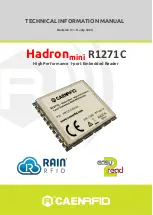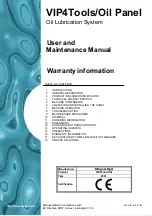
Series Progressive Lubrication Systems Installation Guide
L40000
Page 11
Component Flushing Procedure
(continued)
Coat the I.D. of the tubing with a clean rust inhibitor such
6.
as WD 40 or SP-350. This is best accomplished by filling
the tubing with the fluid and then allowing it to drain out
(see Figure 21).
NOTE
: It is not necessary to wait for the tubing to become dry
after Step 5 since the rust inhibitors recommended in Step 6 are
water displacing types.
Figure 21
Cap the open ends of the tubing. If the capped tubes are
7.
to be stored before installation, this prevents humid air,
dirt, and airborne contami nants from entering the clean
tubes. During installation leave the caps on the tubes as
long as possible to minimize the risk of contamina tion.
If the tubing is installed directly onto a machine after
the cleaning operations, cap any open ends during the
installation process until all connections are made and
checked in order to prevent humid air and dirt or dust
gain ing access to the cleaned surfaces.
The above procedures will completely clean tub ing of all
contaminants except for any rust that may be present in the
bends and middle portion of the tubing where the brush may
not have been able to reach. The rust inhibitors will provide
protection for up to six months of storage.
Proper filtration of the lubricant is essential if sys tem
and equipment damage is to be avoided. Some machine
components, such as high-speed bearings, may require higher
levels of lubricant filtration than others. Filters are available
in sever al micron and pressure ratings to satisfy a variety of
system filtration requirements. It is recom mended that the
lubricant in any lubrication system should be filtered to the
minimum level recommended by the Society of Automotive
Engi neers (SAE) which corresponds to the ISO Stan dard 4406
ratings/specifications of ISO 18/14. It should be noted that
although Series-Progressive system components are designed
to tolerate con tamination levels worse than ISO 18/14,
individual components in the machine may require even higher
levels of cleanliness and filtration.
LUBRICANT FILTRATION REQUIREMENTS
System problems often caused by contaminated fluid can be
avoided. Potential sources of fluid or lubricant contamina tion
are:
Contaminated new oil
•
Built-in contamination resulting from inade quate
•
component cleaning procedures before or during system
installation
Ingressed contamination from open reservoir vents and fill
•
ports, inadequate or worn seals, or components left open
during maintenance procedures
Graco lubrication system components are de signed and
manufactured to high standards in tended to maximize
tolerance to particulate and chemical contaminants. However,
Graco’s products, as well as those provided by other
manufacturers of fluid-handling components, can operate
at their optimum design capability only when supplied with
properly cleaned and filtered fluids and lubricants.
































